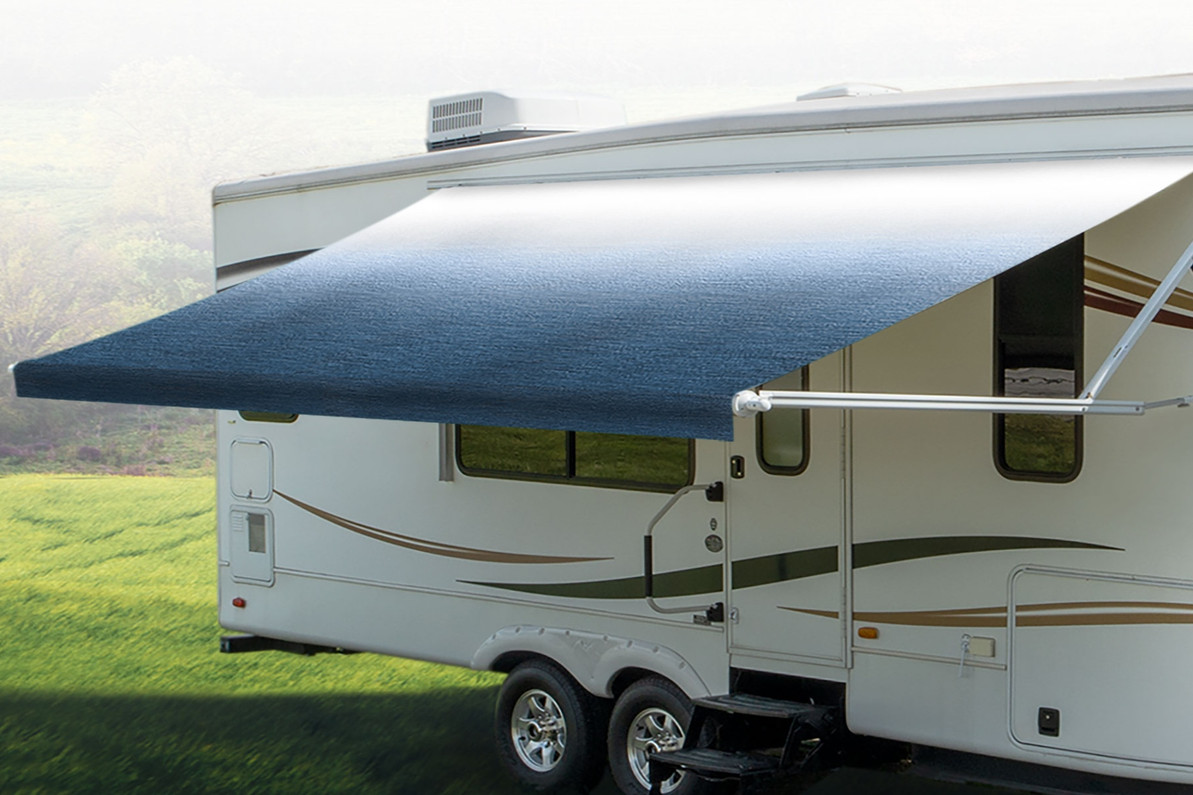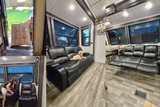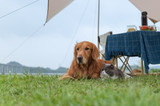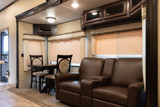RV Awning Material Guide: Everything You Need to Know Before Buying
Awnings are great for expanding your camper’s livable space by extending sun and rain coverage to the area right outside your rig. Many people who have added an awning to their camper absolutely love them, but some face issues relating to the quality of the product and can’t actually enjoy their investment because it’s torn and leaky after one season of use.
If you’ve decided to add an awning to your camper or need to replace your current awning fabric but aren’t sure how to choose a quality product, you’re probably looking for some answers. In this article, we’ll cover all the basics of awning fabric material, dimensional measurements, and additional features to consider when comparing awning materials.
Awning Fabric Types
RV Awnings typically consist of some sort of fabric stretched over a frame which is used for additional overhead coverage and protection on the exterior of a building or motorhome. Fabrics such as canvas, polyethylene, or vinyl are traditionally used in awnings. There are distinguishing factors between these materials that may impact which option is best for you. We will be discussing each fabric type in more detail down below. Awnings provide additional sun, rain, and wind cover, so they must be durable, flexible, and weather-resistant.
Canvas
Canvas is a plain-woven fabric, often made from cotton, hemp, or flax, and is extremely durable but lacks the water-repellent properties of the other materials found on this list. However, canvas can be treated to increase its water-repelling capabilities, but untreated canvas still has some utility. For example, untreated canvas tarps are great for covering firewood because they provide some protection but don’t lock in moisture so that the wood can dry out more efficiently.
If using canvas for an awning, it should be treated so that it is more resistant to moisture in order to prevent mold and mildew buildup. Also, it should be maintained regularly to avoid staining and discoloration. Those who enjoy the look of natural materials may opt for a canvas awning. For RVs, canvas awnings are not very common.

PET
Polyethylene terephthalate, or PET, is the chemical name for a type of polyester that is strong, clear, and lightweight. PET is used for packaging, in clothing as fibers, and in manufacturing. For awning material, PET may be woven into a scrim and then coated with an additional layer of PET to increase durability. Scrim is a term used to describe a strong, coarse woven fabric chiefly used for upholstery of heavy-duty lining. PET awning quality can range from lightweight to heavy duty.

Vinyl
Vinyl awning tarps are similar to PET tarps in that both are made from a PET scrim, but vinyl is slightly more durable because it is coated in PVC, or polyvinyl chloride, instead of PET. Using a PVC coating leads to a more durable and heavier final material. High-quality RV awnings are typically made from vinyl. Most RV awnings are made from vinyl since it is the most durable option on this list.
Dimensional Measurements
In order to make an informed decision regarding your awning purchase, you must be aware of the measurements used and what they mean. Unless you have a background in textiles, these units may not be familiar to you. Keep reading for a quick explanation of the standard measurements taken for tarps and awning fabric materials.
Thickness
The thickness of the tarps or awning fabric is measured in mils, equivalent to 1/1000 of an inch. Lightweight tarps typically range from 5 to 6 mil, whereas super heavy duty tarps range from 23 to 24 mil. The thicker the tarp, the more resistant it is to tears.
Material Weight
The weight of a tarp or awning material can give you an idea of its quality but not the complete picture. Material weight is measured in ounces/square yard and typically ranges from 4 oz to 16 oz.

Weave Count
Similar to a thread count in sheets, the weave count of tarp or awning material refers to the number of threads per square inch of scrim lying vertically or horizontally. This essentially lets you know how tightly woven the fabric is. A higher weave count will be more resistant to tearing and make the tarp heavier.
Denier
Denier is a unit of textile measurement that describes the fiber thickness of individual threads in the fabric. This unit is expressed as grams per 9,000 ft of thread. Fabric with a high denier count is thick, sturdy, and durable, while low denier count fabric is sheer, soft, and silky. The denier count of awning material fabric ranges from 800-1200D.
Tensile Strength
Tensile strength is a material’s ability to resist breaking under tension and is expressed in pounds per square inch. This measurement is helpful to know but is not always provided by the manufacturer. Higher tensile strength will be more resistant to tears but may be less flexible.
Layers
We discussed earlier that most awning material fabric is made from a PET scrim coated with either PET or PVC film for protection against damage and fading. Most awning materials will have at least 3 layers, but some may have an additional layer of black PET on the interior that increases protection from the sun.
Additional Features
You should consider additional points before purchasing an RV awning or RV awning replacement fabric that are not based on dimensional measurements but can still impact the final quality of whatever product you choose.
Treatments
Most awnings fabrics are pre-treated with a UV-resistant coating to reduce sunlight degradation. You may still notice color fading from your awning material over time, as this is almost impossible to avoid completely. Still, you can feel more confident that the protective capabilities of your awning won’t be compromised with a pre-treated material. Regular waterproofing treatments may be necessary if using a material other than PET or vinyl. Most awning materials will not be fire-proof, so if this is important to you, you must treat the fabric with a flame retardant coating. This is not usually recommended or necessary, especially for camper awnings, since motorhomes can be extremely sensitive to fire damage. Fires should be held a safe distance from the camper, which is probably further than your awning will extend anyway.

Seams
Seams are imperative to the stability and durability of your awning cover. Even if the highest quality materials are used, a lousy stitch job will open the door for water leakage, tears, and deformation. All stitching on awning materials should be done with UV-resistant thread or heat-welding. Heat-welded seams are the gold standard for awning materials because this method results in an airtight, watertight bond between two pieces of fabric.
Reinforcement
Awning material fabric may be reinforced in some high-stress regions to reduce damage in problem spots and extend the life of the awning. High-stress areas include corners, the perimeter, and hems. Additional material, a secondary stitch, or grommets may be used to reinforce the material.

Warranties
Many awning fabric material manufacturers include some type of warranty with their products. If they do not, that may be a bad sign in and of itself. Typically, limited warranties of 3 to 5 years come included with awning fabric. Read the fine print of what the warranty covers. Oftentimes, this does not include discoloration or issues pertaining to installation.
If you have any questions regarding awning fabric material, you can ask us down below or call our Customer Care team for more information!
Recent Posts
-
Traveling to the RV Hall of Fame in Elkhart, IN
If you are traveling to Elkhart, IN to see the RV Hall of Fame, getting off the toll road at exit 96 …Nov 14, 2025 -
Best RV Air Conditioners of 2025: An Expert Guide From RecPro
Quick Answers Best overall RV air conditioner: RecPro 15K Quiet AC with Heat Pump (RP-AC3800) Best f …Oct 29, 2025 -
The Nuclear Nomads Expand Sofa with New Recliner Section Install
The Nuclear Nomads are a full time RV family living in south Florida. Andi and Joey value quality ti …Oct 24, 2025 -
Trailer Wiring Guide: How to Wire Your Trailer for Safety and Efficiency
Table of Contents 1. Common Types of Trailer Connectors 2. Trailer Wiring Diagrams: Color Codes and …Aug 20, 2024 -
How to Keep Your Pets Safe While Camping
RVing and camping are a great getaway from the hustle and bustle of work and the city and the day-to …Jul 02, 2024 -
Why Replace Your RV Furniture?
You may wonder when is the best time to replace your RV furniture. There is no one right answer to t …May 20, 2024







